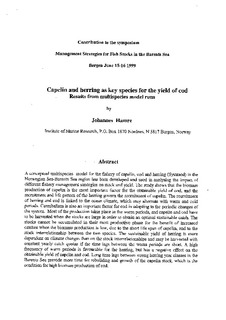Capelin and herring as key species for the yield of cod: Results from multispecies model runs
Conference object
Permanent lenke
http://hdl.handle.net/11250/106689Utgivelsesdato
2002Metadata
Vis full innførselSamlinger
Sammendrag
A conceptual multispecies model for the fishery of capelin, cod and herring (Systmod) in the Norwegian Sea-Barents Sea region has been developed and used in analysing the impact of different fishery management strategies on stock and yield. The study shows that the biomass production of capelin is the most important factor for the obtainable yield of cod, and the recruitment and life pattern of the herring govern the recruitment of capelin. The recruitment of herring and cod is linked to the ocean climate, which may alternate with warm and cold periods. Cannibalism is also an important factor for cod in adapting to the periodic changes of the system. Most of the production takes place in the warm periods, and capelin and cod have to be harvested when the stocks are large in order to obtain an optimal sustainable catch. The stocks cannot be accumulated in their most productive phase for the benefit of increased catches when the biomass production is low, due to the short life span of capelin, and to the stock interrelationship between the two species. The sustainable yield of herring is more dependent on climate changes than on the stock interrelationships and may be harvested with the constant yearly catch quotas if the time lags between the warm periods are short. A high frequency of warm periods is favourable for the herring, but has a negative effect on the obtainable yield of capelin and cod. Long time lags between strong herring year classes in the Barents Sea provide more time for rebuilding and growth of the capelin stock, which is the condition for high biomass production of cod.
Beskrivelse
Management strategies for the fish stocks in the Barents sea. Proceedings of the 8th Norwegian-Russian Symposium. Bergen, 15-16 June 1999.
Serie
IMR/PINRO Joint Report Series5/2002
